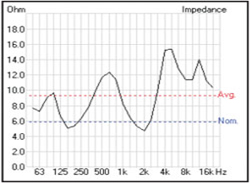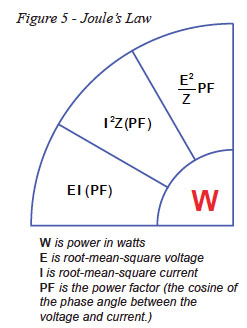
The impedance of household appliances is seldom specified. Instead, a power or current rating is provided. This is because the available voltage is always the same, so the current draw or power draw is the parameter of interest to prevent circuit overload.
Voltage, current and impedance are related by the Ohm’s law. Their relationship to power is described by Joule’s law (Figure 5, below), often called the “power equation.”
With amplifiers a different rating scheme must be used than for household appliances. Since the available voltage is amplifier setting-dependent, there is no way to know in advance what the current draw will be. In short “It depends.”
So instead of listing the current draw or power draw, the load impedance is given. This gives the user the information that they need to assure that the amplifier is not excessively loaded by the loudspeaker(s).
The current drawn by the loudspeaker is determined by its impedance and the spectrum of the signal. Since the impedance is loudspeake dependent, it is good practice to measure it for the following reasons.

Reasons To Measure
There are three dominant reasons for measuring the impedance of a loudspeaker.
1) Loading. The first is to assure that it does not overload the amplifier. As with household appliances, lower impedance allows more current to flow. If the loudspeaker’s impedance is very low, the amplifier may not be able to source sufficient current to accurately reproduce the audio waveform.
While the peaks of the impedance curve are its most striking features, the minima of the curve are of greater significance to the amplifier. If an amplifier is driving a single loudspeaker, it is unlikely that an overload condition will exist.

2) Wire Gauge. The second reason is to aid in determining the required wire gauge used to connect the loudspeaker to the amplifier. If one were to place a voltmeter across the amplifier terminals and take a reading (sine wave recommended), and then place the voltmeter across the loudspeaker terminals and take another reading, the difference is the voltage drop across the loudspeaker cable.
This is the unavoidable consequence of using wire to complete the circuit. While the wire resistance can never be reduced to zero, it should be minimized to assure optimum voltage transfer to the loudspeaker.
A second benefit of low wire resistance is that it improves the damping factor of the amplifier/loudspeaker interface. If the level difference between the two readings exceeds 0.5 dB, a larger wire gauge should be used.
3) Reactive Loads. The third reason for measuring the impedance of a loudspeaker is to assure that the loudspeaker is not excessively reactive. A reactive load reflects current back to the amplifier. If the reactance is excessive, the amplifier may become unstable.
